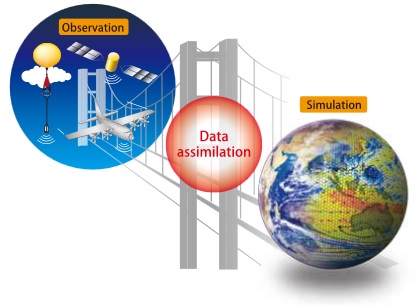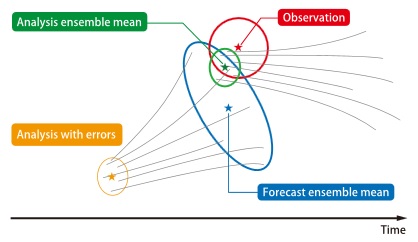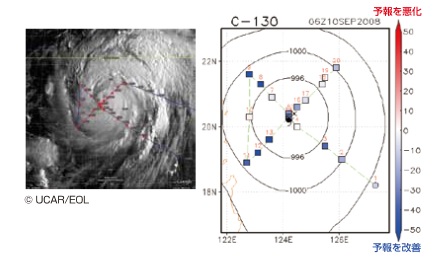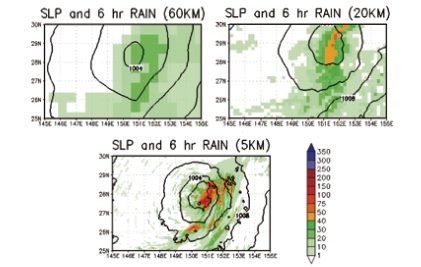Introducing DA
What is Data Assimilation?
Simulations are based on modeling the real world, therefore, gaps between simulations and the real world are inevitable. Data assimilation fills in the gaps by integrating actual observation data into simulations, which enhances a simulation's accuracy. We are developing advanced algorithms for data assimilation on supercomputers, based on our previous achievements in meteorological applications. Our research is contributing to improvement of large-scale meteorological simulations, as well as facilitating broader applications of data assimilation.
Applications
Prediction of Sudden Rainfall
"Big Data Assimilation: Real-time 30-second-refresh Heavy Rain Forecast Using Fugaku During Tokyo Olympics and Paralympics" is a finalist for the 2023 Gordon Bell Prize for Climate Modelling
- R-CCS News & Announcements (September 22, 2023)
Predicting torrential rain with the supercomputer Fugaku
- RIKEN Press Release (July 15, 2021)
Predicting a sudden local rain method up to 30 minutes later
Supercomputer and high-tech weather radar come together to predict sudden torrential rains
- RIKEN Press Release (August 9, 2016)
New system promises more rapid and accurate prediction of rainfall
- RIKEN Press Release (July 4, 2017)
Prediction of Typhoon and Heavy Rain
- RIKEN Press Release (January 18, 2018)
Predictability of Global Atmosphere
- RIKEN Press Release (July 23, 2014)
- RIKEN Press Release (August 20, 2020)
Other Examples
- Hydroelectric Dam Operation
- Sustainability
- Vegetation
- Manufacturing
- Cell fate
- Health Prediction
- Red-tide
Introduction to Data Assimilation
Function of Data Assimilation
Data assimilation is like a bridge between observation and simulations. In the case of weather forecasting, observations from radiosondes (weather balloons) and weather-observation satellites, for example, are integrated into numerical weather prediction simulations. As a result, we obtain more accurate weather forecasts.

Note: the figure on the right is based on simulation results from the global cloud-resolving model NICAM and NASA satellite imagery. Courtesy of Ryuji Yoshida.
Our Method of Data Assimilation
Data assimilation is based on applied mathematics and statistics, and it can be approached in a number of ways. Among others, we have been focusing on LETKF (Local Ensemble Transform Kalman Filter), and advanced data assimilation method, and have been using it to improve simulation accuracy.

LETKF:
The results of multiple simulations from slightly different initial conditions (orange circle) tend to diverge and become more uncertain (blue circle) over time.
LETKF takes into account current observations (red circle) and so reduces the uncertainty (green circle).
These more accurate results are then used to initialize new simulations.
Evaluating Impact of Observation Data
Data assimilation improves simulation accuracy by using observation data; it can also be employed to estimate quantitatively how much each datum contributes to the improvements. Such studies may lead to more efficient and effective observation strategies.

A data assimilation method is used to estimate the impact of meteorological observation data such as temperature, humidity, winds and pressure near a typhoon core region taken during a reconnaissance flight by the US Navy. Among the 20 observation locations on the flight back (blue line in the left image, green dashed line in the right figure), most observations improved the forecasts, while a few slightly degraded it.
Towards Future Weather Forecasting
Our group is working to advance our data assimilation system and optimize it for the supercomputer "Fugaku". High performance computers like "Fugaku" can be regarded as conventional supercomputers that will be used for weather forecasting 10 years from now. In utilizing "Fugaku" today, we are preparing for the future by developing data assimilation techniques that can be implemented in the next 10 years for more accurate analysis and forecasts.

Precipitation patterns over the ocean southeast of Japan, analyzed by our data assimilation system based on the Weather Research and Forecasting (WRF) model. Using the K computer to perform data assimilation at a higher resolution (finger grid cells) results in a more precise precipitation pattern.


